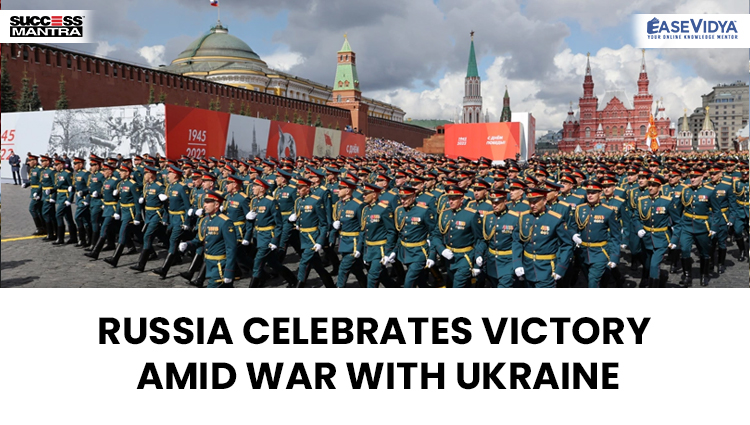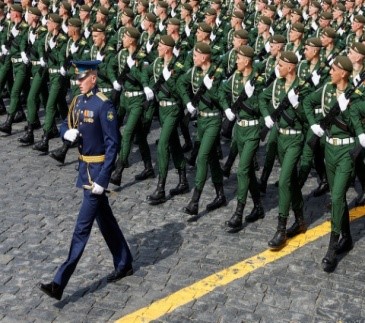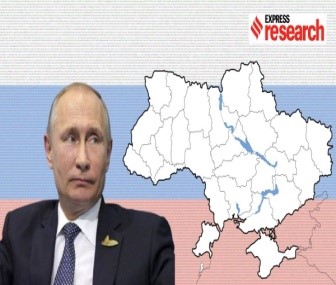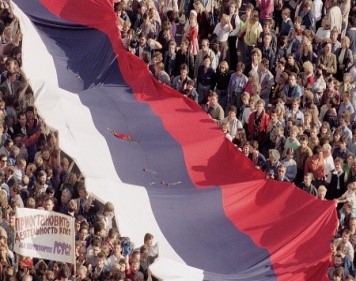
RUSSIA CELEBRATES VICTORY AMID WAR WITH UKRAINE
RUSSIA CELEBRATES VICTORY AMID WAR WITH UKRAINE
Russia celebrates ‘Victory Day’ every year on May 9. Victory Day is one of the most significant national holidays in Russia as it marks the Soviet Union's victory over Nazi Germany during the Second World War. During the Victory Day 2022 parade in Russia, President Putin flaunts Russia's military capabilities and the bravery of the soldiers fighting for the country. Victory Day 2022 in Russia will also be different this year as the country's war on Ukraine continues and the President justifies the war by comparing it with the previous struggle against Nazism in Germany.

WHEN IS VICTORY DAY 2022?
Victory Day is a grand celebration and one of the most significant national holidays that takes place every year in Russia on May 9. Victory Day is celebrated in Russia with a massive military parade and other festivities organised on this day to celebrate the victory over the Nazis.
WHY IS THIS DAY IMPORTANT THIS YEAR?
Over the last few years, Russian President Vladimir Putin during his address on Victory Day has warned of new battles ahead. Victory Day 2022 in Russia is expected to be a turning point in the Ukraine war. Till now, Putin has justified the war on Ukraine claiming that he was denazifying the country and continuously used World War II, Holocaust, and Nazism to legitime the attack on Ukraine.
Current Affairs Notes By Success Mantra Coaching Institute GTB Nagar Delhi CLICK HERE
WHY IS VICTORY DAY CELEBRATED IN RUSSIA?
Every year on May 9, Russia celebrates Victory Day to commemorate the defeat of the Nazis during the Second World War. Notably, while the allies celebrate Victory Day or Victory in Europe Day on May 7- the day Nazis surrendered in France. Joseph Stalin, Soviet Union Leader, chose to celebrate the victory over Nazis in Soviet-controlled Berlin, Germany the next day. Later, Russia's first post-Soviet President Boris Yeltsin made the victory day celebration an annual affair; however, it was Soviet Leonid Brezhnev who announced May 9 as the national holiday.
CONFLICT B/W RUSSIA & UKRAINE
Recently, Russia recognized two independent republics out of Ukraine (Donetsk and Luhansk - Donbass region), signaling the inevitable war that followed. In the declaration of war, the Russian President described Ukraine with no history or identity, and was entirely and fully created by the former Soviet Union (USSR). Ukraine and Russia share hundreds of years of cultural, linguistic and familial link.

WHAT IS THE EARLY HISTORY OF UKRAINE?
A millennium ago, what is Ukraine today lay at the heart of the Kyivan Rus’ (Rus’ land). Kyivan Rus was a federation of the East Slavic, Baltic, and Finnic peoples of eastern and northern Europe, with its capital in Kyiv. Modern Ukraine, Russia, and Belarus all trace their cultural ancestry to the Kyivan Rus’. The Kyivan Rus’ reached its greatest size and power in the 10th and 11th centuries. In the mid-13th century, the Kyivan Rus’, weakened by the decline of trade as the Byzantine Empire collapsed, fell apart under the onslaught of the Mongol Golden Horde, who sacked Kyiv in 1240. The Byzantine Empire, also called Byzantium, was the eastern half of the Roman Empire, based at Constantinople (modern-day Istanbul) that continued on after the western half of the empire collapsed. The Golden Horde was the group of settled Mongols who ruled over Russia, Ukraine, Kazakhstan, Moldova, and the Caucasus from the 1240s until 1502.
WHAT ARE OTHER SALIENT FEATURES OF UKRAINE?
Ukraine is in the east of Europe, and is bound by Russia to its northeast, east, and southeast, and the Black Sea in the south. In the southwest, west, and north, Ukraine shares borders, in the anticlockwise direction, with Moldova, Romania, Hungary, Slovakia, Poland, and Belarus. In July 2021, Ukraine’s population was estimated at 43.7 million. Of this, 77.8% was of Ukrainian ethnicity and 17.3% was Russian and Ukrainian and Russian speakers made up 67.5% and 29.6% of the population respectively.
Relations with India: India is Ukraine’s largest export destination in the Asia Pacific region. The country’s major export to India is sunflower oil, followed by inorganic chemicals, iron and steel, plastics, and chemicals. Ukraine’s major import from India is pharmaceutical products.
WHEN DID UKRAINE INCORPORATE INTO RUSSIA?
In the 18th century, Empress Catherine the Great (1762-96) of Russia absorbed the entire ethnic Ukrainian territory into the Russian Empire. The Tsarist policy of Russification led to the suppression of ethnic identities and languages, including that of the Ukrainians. Within the Russian Empire though, many Ukrainians rose to positions of prosperity and importance, and significant numbers migrated to settle in other parts of Russia. More than 3.5 million Ukrainians fought in World War I on the side of the Russian Empire, but a smaller number fought against the Tsar’s army with the Austro-Hungarians.

Ukraine Becoming part of USSR: The World War I led to the end of both the Tsarist and Ottoman empires. As a mainly communist-led Ukrainian national movement emerged, several small Ukrainian states sprang up. Months after the Bolsheviks took power in the October Revolution of 1917, an independent Ukrainian People’s Republic was proclaimed, but a civil war continued between various claimants to power, including Ukrainian factions, anarchists, Tsarists, and Poland. In 1922, Ukraine became part of the Union of Soviet Socialist Republics (USSR). The Soviet Union had its roots in the October Revolution of 1917, when the Bolsheviks, led by Vladimir Lenin, overthrew the Russian Provisional Government that had replaced Tsar Nicholas II.
WHAT WAS THE OTTOMAN EMPIRE?
An empire created by Turkish tribes in Anatolia (Asia Minor) that grew to be one of the most powerful states in the world during the 15th and 16th centuries. The Ottoman period spanned more than 600 years and came to an end only in 1922, when it was replaced by the Turkish Republic and various successor states in southeastern Europe and the Middle East. At its height the empire encompassed most of southeastern Europe to the gates of Vienna, including present-day Hungary, the Balkan region, Greece, and parts of Ukraine, portions of the Middle East now occupied by Iraq, Syria, Israel, and Egypt, North Africa as far west as Algeria, and large parts of the Arabian Peninsula.
STATUS OF UKRAINE AFTER THE COLLAPSE OF USSR
In 1991, the USSR was dissolved. The Demands for independence had been growing in Ukraine for a couple of years previously, and in 1990, over 300,000 Ukrainians created a human chain in support of freedom. This was followed by the Granite Revolution when students sought to prevent the signing of a new agreement with the USSR. On 24th August, 1991, after the failure of the coup to remove President Mikhail Gorbachev and restore the communists to power, the parliament of Ukraine adopted the country’s Act of Independence. Subsequently, Leonid Kravchuk, head of the parliament, was elected Ukraine’s first President. In December 1991, the leaders of Belarus, Russia, and Ukraine formally dissolved the Soviet Union and formed the Commonwealth of Independent States (CIS). However, Ukraine’s parliament, the Verkhovna Rada, never ratified the accession, so Ukraine was legally never a member of the CIS.

PRAVAHINI Current Affairs Notes By Success Mantra Coaching Institute GTB Nagar Delhi CLICK HERE
TEST YOURSELF
Q.1 Which of the following countries have recently celebrated their 'Victory Day' on 9th May amidst its ongoing tensions with Ukraine?
- United States of America
- Germany
- Russia: ANSWER
- None of the above-mentioned
Q.2 Every year on May 9, Russia celebrates Victory Day to commemorate the defeat of the _________ during the Second World War?
- German Nazis: ANSWER
- Japanese
- Italian Fascists
- None of the following
Q.3 Recently, Russia recognized two independent republics out of Ukraine. Which of the following are these two?
- Kyiv and Luhansk
- Donetsk and Luhansk: ANSWER
- Odessa and Donetsk
- None of the above
Q.4 Which of the following given statements is/are incorrect in the reference to the Tension rising between Ukraine & Russia?
- The Moscow Summit in the Normandy format was held in December 2019, the first meeting in three years & During the summit, the leaders of Ukraine, Russia, United States of America and France & United Kingdom stressed complete cease-fire and loyalty to the Minsk Agreement: ANSWER
- The summit did not diminish the clashes, but Russia, Ukraine and the OSCE later made a comprehensive cease-fire decision starting from July 27, 2020, which was maintained until 2021.
- Ukraine pointed to the increasing number of Russian troops in the north and east sides of Ukraine’s border and Crimea.
- None of the following
Q.5 To which of the following international organisations does the Ukraine urges to speed up its membership?
- Organization for Security and Co-operation in Europe (OSCE)
- South Asian Association for Regional Cooperation (SAARC)
- Quadrilateral Security Dialogue (QUAD)
- North Atlantic Treaty Organization (NATO): ANSWER












0 Comment